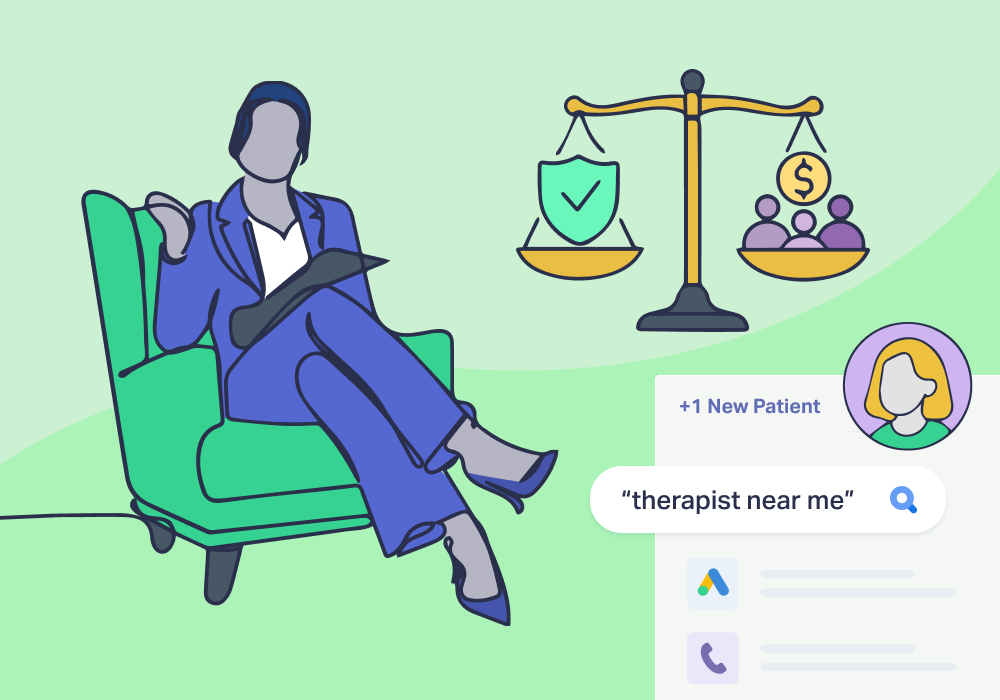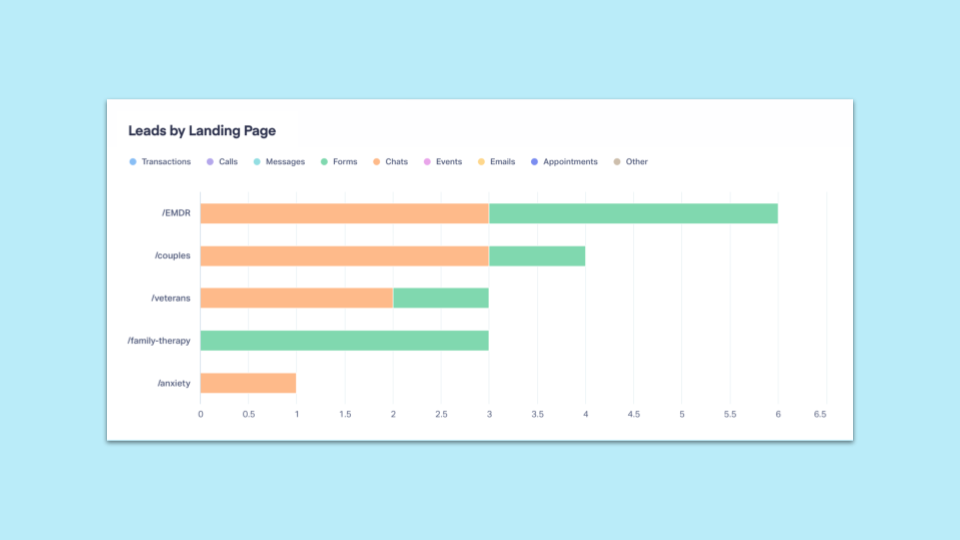
As a therapist, you didn’t go into practice to chase leads or optimize ad campaigns. You entered the field to help people—to provide support, create safety, and guide others through some of the most difficult moments of their lives.
So when it comes time to grow your practice, it’s natural to feel uneasy about marketing. How do you promote your services without crossing ethical boundaries? How do you find clients who are a good fit—and avoid attracting people who might not benefit from your specific approach?
The answer lies in ethical, data-driven strategies: approaches that honor your professional values, respect your clients’ privacy, and still help you grow a thriving, sustainable practice.
Am I Helping People, or Selling to Them?
You became a therapist to heal people's pain, not to make money from it—but the line between those two things can feel blurry at first when it comes time to start advertising your services.
Should you run Google Ads? Write blog posts? Redesign your website? It all feels overwhelming and dangerously close to self-promotion for its own sake, which feels icky at best.
The good news is that you don't need to choose between helping people and selling to them. If your marketing is reaching the right people, then you'll be doing both. When your marketing is working, it’s about helping the right people find you, at the right time, in a way that builds trust instead of breaking it.
Read More: Agency Uses Lead Tracking to Reach the Right Customers, Grows ACV by 50% [Case Study]
How Tracking Leads = Building Trust
When you advertise without a lead tracking system, all you can see is which ads, campaigns, and content are driving clicks and conversions. You can’t trace each of those clicks back to the person who made them, which means you can’t tell which ads are generating clicks from real potential clients and which are attracting clicks from the wrong people (or getting initial clicks from the right people and failing to land them as clients).
By tracking where your leads come from—and just as importantly, who actually becomes a good client match—you can start to see which parts of your marketing are doing what you want them to do. Maybe a blog post on anxiety generates a lot of pageviews but rarely leads to consultations. Meanwhile, a less-trafficked blog post on burnout in new parents, leads to clients who feel aligned, motivated, and ready to work.
When you start tracking leads, you’re no longer stuck guessing whether your efforts are helping people or just chasing numbers. You can actually see which messages and channels are drawing in the clients who are the best fit for your work.
That clarity becomes your ethical compass. You don’t have to lean on sensational promises or cast a wide net. You can refine your marketing with confidence, knowing you're investing in the messages that resonate with the people you’re best equipped to help.
Creating Content That Builds Trust
Marketing isn’t just about being seen; it’s about being seen and recognized as a trustworthy guide. It can often feel like “sales-y” content violates trust rather than building it, which is the opposite of what you want to achieve when positioning yourself as a potential lifeline for people who are struggling.
The best way to create trust-building marketing content is to speak directly to the people you want to help from a position of real empathy. You spend most of your work day talking to the exact types of people you want to target; put yourself in their shoes and consider what would have been most helpful to them when they first found you.
1. Educational Articles
Write blog posts or resource pages that address the questions your ideal clients are already asking, like:
- “How do I know if I need therapy?”
- “What does anxiety look like in working parents?”
- “How can I support my teen through grief?”
Again, the goal isn’t to provide a diagnosis or a self-serve solution in the span of an article. It’s to inform, normalize, and position yourself as a knowledgeable authority that readers can envision themselves working with to solve their own individual problems.
You know you’re great at what you do, so if you can create content that demonstrates that and make sure it gets in front of the right people, you won’t have to do too much “pitching”. Your talent as a therapist will sell itself.
2. Transparent About Page
Especially for medical practitioners, the “About” page is often the most visited page on a site—which means it’s also one of the most influential pieces of content you’ll create. So it’s especially important to make sure your site tells clients what they want to know.
Sure, your professional background and educational training is important. But beyond that, clients want to know:
- Who are you, really?
- What’s your approach to therapy?
- What do you specialize in?
- Do you seem like someone I could talk to?
- Are you someone who understands my personal, cultural, and religious contexts, and can you meet me where I am?
At the same time, this page shouldn’t be a novella—remember that the people who need your help don’t have a ton of extra mental bandwidth to spend on parsing long walls of text. You don’t need to share everything, but showing up with warmth and clarity builds trust.
3. Service Pages That Clarify More Than They Sell
In most industries, product and services pages are often referred to by marketers as “money pages,” since they’re the pages where potential customers are ultimately convinced to buy.
As a therapist, your service pages are still going to be some of your biggest conversion pages, but they shouldn’t feel like traditional sales pages. Instead, use your service to explain what you offer in a non-clinical, relatable way. Rather than just saying you offer CBT or EMDR, explain what that means from a client’s perspective. Help people understand what they can expect from the process.
4. Local SEO Pages
Since many clients prefer to find a therapist they can see in person, it helps to create content specific to your region. This might include location-based landing pages or blog content tailored to the unique stressors of your local community—like a “Couples Therapist in Chicago” landing page or an article on combat PTSD in a city with a large veteran population.
Measuring Page Impact
Deciding which pages you want to incorporate into your strategy is only half the battle. The real work begins when you start tracking how your leads move through your content before ultimately making a call or booking an appointment. When you can see which pages leads touched before they became clients, you can start to see which pages are the most effective at attracting people who are a good fit for your practice, and you can use that as a model for future content or for updating pages that aren't as impactful.
Right People, Right Time: Marketing That Meets People Where They Are
Even the most thoughtfully crafted content can fall flat if no one sees it or if it reaches people before they’re ready. That’s why content creation is only half the equation. The other half is strategic placement: making sure the right message reaches the right person at the right moment in their journey.
Stage 1: Quiet Curiosity
At this stage, someone is likely experiencing distress, but hasn’t yet decided to seek therapy. They may be Googling phrases like:
- “Why do I cry at work?”
- “How to stop overthinking everything”
- “Do I have social anxiety?”
This is where educational blog content shines. Blog posts that explore symptoms, normalize emotional experiences, and gently introduce therapy as a potential next step can make a big impact here.
To get this content in front of early-stage clients, consider:
- SEO optimization: Use plain language and structure content around questions your ideal clients are actually asking—not clinical terminology.
- Paid search campaigns (broad match or question-based keywords): Bid on terms like “how to deal with burnout” or “am I depressed quiz” and promote blog articles that provide insight without pressuring action.
- Social media posts or boosted content: Short-form versions of your educational content can reach people in scroll mode, planting the seed that therapy could help.
Stage 2: Active Research
Now they’re past the “maybe something’s wrong” phase and moving into “I think I want help.” They’ll likely:
- Visit several therapist websites
- Read About pages
- Check credentials and modalities
- Revisit helpful articles they’ve seen before
This is the time to surface your About page, Service pages, and FAQs—the content that communicates not just what you do, but who you are. This is where trust is built.
To engage them here:
- Retargeting campaigns: If someone has visited your blog or homepage but didn’t take action, use Google Ads or Facebook Ads to retarget them with helpful resources or reminders. For example, show them an ad that links to your “What to Expect in Your First Session” page.
- Email opt-ins and follow-ups: If your blog includes a lead magnet (like a short guide on “How to Know If You’re Ready for Therapy”), an automated email sequence can provide additional resources and deepen the connection.
- Internal linking and content journeys: On your site, make it easy for visitors to move from a blog post to your About or Services pages. Guide them from curiosity to clarity.
Stage 3: Readiness to Act
At this point, they’re ready to reach out. The right placement now is less about education and more about removing friction.
Here’s how to support action:
- Clear calls to action on every page: Whether they’re reading your blog or About page, there should be a low-pressure way to take the next step—book a consultation, fill out a contact form, or call your office.
- Click-to-call and mobile-friendly contact pages: Many people who are ready to act do so from their phones. Make it easy.
- Location-based Google Ads: For high-intent searches like “therapist near me accepting new clients,” use tightly focused search ads that direct people to a conversion-optimized landing page.
- Scheduling integrations: If you offer online booking, highlight that convenience in your ad copy and CTA buttons to capture the momentum of someone who’s ready now.
Meeting Clients at the Moment They’re Ready
When someone is finally ready to reach out for help, small details can make a big difference. A clear call to action, a mobile-friendly contact page, or an easy-to-use scheduling tool can be the deciding factor between taking the next step or putting it off.
Lead tracking gives you the clarity to support those moments. Instead of guessing which messages or touchpoints are helping people take action, you can see the journey real clients took—and make sure your marketing is aligned with what actually works. Instead of spewing random content into the universe, you’re creating thoughtful content that reaches the right people in the right way, at the right time.
Ready to start growing your practice with detailed lead tracking? Start your 14-day free trial today.
Get a FREE presentation of WhatConverts
One of our marketing experts will give you a full presentation of how WhatConverts can help you grow your business.
Schedule a Demo
Grow your business with WhatConverts







